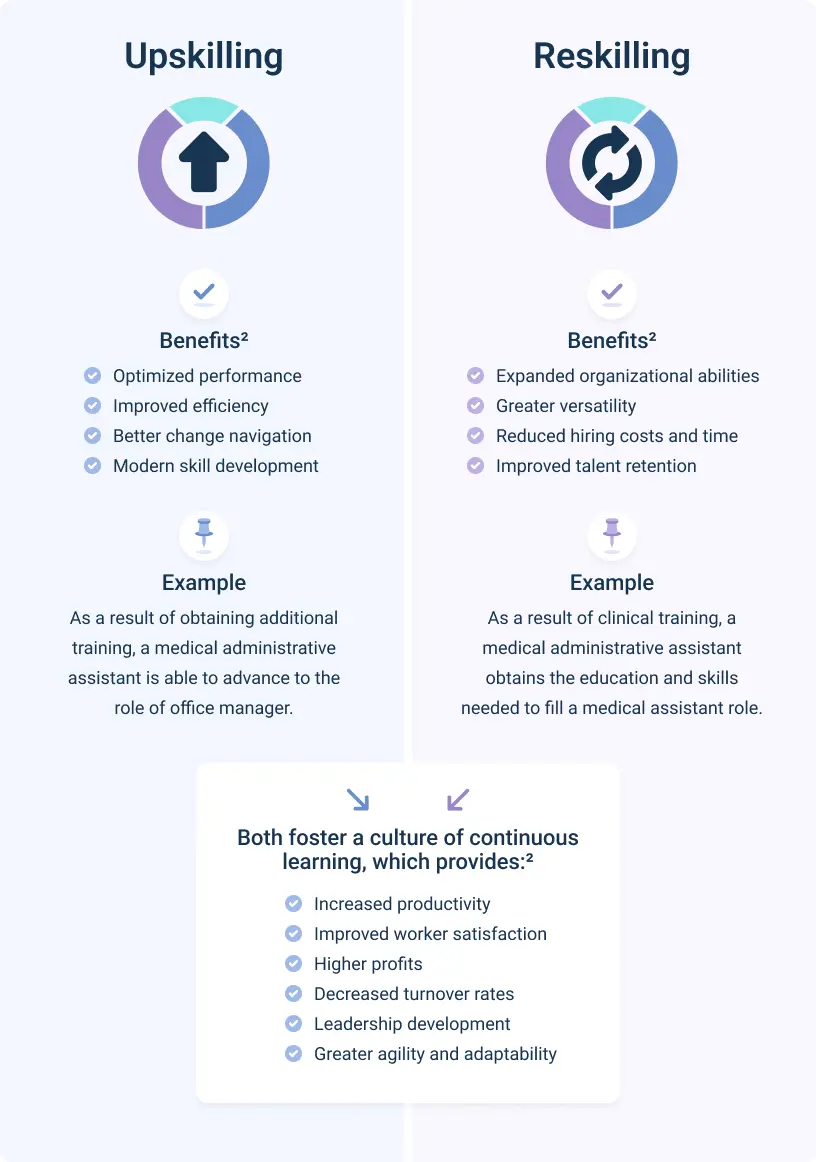A Helpful Guide for CNOs

10 Key Factors to Consider When Choosing Upskilling and Reskilling Training Programs
Chief Nursing Officers (CNOs) wear many hats. Some duties are organizational (such as setting patient care standards), others are administrative (like managing an operating budget), and still others revolve around leadership (overseeing employees in a variety of nursing roles).1 One important function related to the latter is selecting upskilling and reskilling training programs that can help take their nursing staff to a higher level.


Healthcare Workforce Training for Worker Retention and Attraction
One potential benefit of healthcare workforce upskilling and reskilling is better worker retention. Finding ways to improve the retention of nursing staff is especially critical at a time when we are facing a worldwide healthcare worker shortage. Yet, finding a solution to this shortage isn’t easy due to compounding factors such as worker burnout, inequality issues, regulations, and other components of our current healthcare systems.3
According to some surveys, upskilling and reskilling may help ease these effects. For example, Gallup’s 2021 American Upskilling Survey involved 15,000 U.S. adults and found that 57% were “extremely” or “very” interested in taking part in an upskilling program.4 Of those who participated in this type of training, 71% said that it increased their satisfaction with their job and/or career, with 39% reporting that it enabled them to advance while remaining with their current employer.
Another survey that was commissioned by UMA Education, Inc., the parent company of Nasium Training, was conducted in February 2023. It involved 1,000 healthcare workers and found similar results regarding training and retention, noting that:5
- The third most common reason for employees leaving their current healthcare jobs was not being able to see career growth opportunities.
- Three in four healthcare employees (75%) indicated that they’d stay with their employer longer if that employer offered a clear career path – including training.
- Employers with lower turnover rates were more likely to offer career pathing than higher-turnover facilities at 27% versus 13%.
Offering access to upskilling and reskilling programs also aids in attracting new employees. The Gallup study reported that almost two-thirds of workers felt that upskilling was very important when evaluating a job, with only health insurance and disability ranking higher in priority for young adults just entering the workforce.6
The 2023 survey adds that providing employees with more benefits, such as through offering employer-sponsored healthcare workforce training, was attractive to 95% of prospective job candidates.3
10 Key Factors to Consider When Selecting an Upskilling and Reskilling Training Solution
Just as no two healthcare facilities are the same, there are also differences in healthcare upskilling and reskilling training solutions. How do you know which one to choose as a CNO? Here are several key factors to consider.
#1: A Patient-Centric Approach
On April 12, 2022, the Centers for Medicare & Medicaid Services (CMS) launched its National Quality Strategy. This initiative aims to provide patients with the safest care and highest-quality outcomes possible, and its focus is “a person-centric approach from birth to death as individuals journey across the continuum of care.”7
A person-centric approach, also referred to as a patient-centric approach, involves healthcare providers and patients working in collaboration to focus on (and meet) each patient’s individual needs. Upskilling and reskilling programs that promote this approach when training healthcare workers can help support this initiative and its desired impacts.
#2: Customizable Training Programs and Modules
Talk to other CNOs and you’ll likely learn that, while your challenges may be somewhat similar, they’re also unique to your facility and workers. Different healthcare organizations have their own unique strengths as well.
That’s why it’s so beneficial to choose a training solution that can be customized to your facility, your goals, your workers, and their skills gaps. Through customization, you’re able to gain access to all the components you need while avoiding the purchase of a one-size-fits-all solution that fails to address your specific issues or challenges – also failing to capitalize on your team’s strengths.
#3: Continuous Learning Culture
The healthcare field is constantly changing. This requires workers to stay updated on the latest advancements, also learning how to apply these advancements and collaborate when needed. Creating a continuous learning culture can help healthcare organizations stay in pace with, or even ahead of, these advancements.
The first step to creating a culture of continuous learning is for organizational leaders, like CNOs, to recognize that it’s necessary to develop this perspective system-wide.8 Once this perspective is adopted, upskilling and reskilling programs can provide the knowledge and skills to be learned.
#4: Cross-Training Current Team Members
Sometimes the quickest way to fill an open slot is to prepare a current employee in a different position to fill that role. Reskilling can help create cross-functional teams, where multi-skilled workers are able to help fill vacancies in other open roles at a moment’s notice.
When researching reskilling solutions, consider which cross-training opportunities exist. What are some positions within your organization that are facing severe worker shortages but can potentially be filled through reskilling efforts? If you’re unsure, inquire with the training provider. They can help you determine which cross-training programs could potentially provide the greatest benefit based on your situation and needs.
#5: Leadership Development
One way that low nursing staff retention rates negatively impact healthcare organizations is by not creating a sufficient pipeline of workers who will become the next generation of nurse leaders and even CNOs.9 This makes helping workers achieve their career goals through training and support an important part of succession planning for leadership roles.
Talk with your assigned staff and ask what they want to achieve in their healthcare careers. What types of positions would they like to hold and why? Look for upskilling and reskilling programs that will work for and with these workers, enabling them to follow the career path they desire while remaining with your organization.
#6: De-Escalation Training
Nursing professionals can help patients live healthier, higher-quality lives. But that doesn't mean that they’re always met with happiness and joy. In fact, one 2022 analysis revealed that 57 assaults were committed on nursing personnel each day – equating to two personnel being assaulted every hour.10
This highlights the importance of nursing staff knowing how to defuse tense situations and maintain a safe environment. Work with a training solution provider that offers training in de-escalation techniques. This can help your team learn how to respond to these all-too-common incidents.
#7: Training Delivery Model
Another factor to consider when evaluating a healthcare upskilling and reskilling training provider is their delivery model. Are programs offered in person, online, or a combination of both?
Providing your staff access to training programs that are convenient for them to attend can make for a better learning experience. It can also help reduce the risk that they’ll feel overwhelmed or overloaded by trying to add schooling to their already long list of obligations at work and home.
#8: Time Commitment
Similar to looking at a training solution’s delivery model, CNOs should also consider how much time it will take workers to complete the training programs. The reason for this is two-fold. One, lengthy programs may be less desirable to nursing staff. Two, if your goal is to quickly fill open positions, a shorter training period can help you meet this goal.
Does the training solution offer upskilling and reskilling programs that can be completed in a matter of weeks or months, or can workers plan to spend years before getting the training they want or need? Secondarily, consider whether employees can participate in some or all of their training during work hours. This may help relieve any time commitment issues.
#9: Feedback and Assessment Mechanisms
Imagine that you’ve gone through a healthcare training program. How would you feel about that training if after it was over, you had access to ongoing support? Probably pretty good. That’s the type of feeling you want your staff to have when it comes to the upskilling and reskilling programs you choose. So, look for solutions that offer this benefit.
Equally important is to choose a training provider that also asks for feedback. This suggests that they care enough about their institution and students that they want to know what they do well and where they can improve. Your relationship should be a partnership in which you can talk openly so that you each benefit.
#10: Return on Investment
Finally, training solutions should be able to demonstrate a return on investment (ROI) for the healthcare organization. Factors to consider when determining training-based ROI may include:
- Increased worker attraction or retention rates
- Increased productivity or employee output
- Increased worker satisfaction or happiness on the job
- Improved patient satisfaction levels
- Reduced costs (i.e., due to using products more efficiently)
Nasium Training Offers Upskilling and Reskilling Programs
If you’re a CNO in search of training for your staff, Nasium Training specializes in upskilling, reskilling, and cross-skilling programs for healthcare workers. These programs are customizable to meet the specific needs of your healthcare organization.
If you have any questions or would like to discuss your options, contact us today. It can be hard enough to be in a CNO position. Let us help you reduce some of the stress by creating training programs designed to resolve some of your biggest staffing challenges. Let us help you better attract and retain top nursing talent.
1 Christinasen S. What Is a Chief Nursing Officer (CNO)? Nurse Journal. https://nursejournal.org/careers/chief-nursing-officer/
2 U.S. Chamber of Commerce. Upskilling vs. Reskilling. https://www.uschamber.com/co/run/human-resources/upskilling-vs-reskilling
3 Džakula A, Relić D, Michelutti P. Health Workforce Shortage – Doing the Right Things or Doing Things Right? Croatian Medical Journal. https://www.ncbi.nlm.nih.gov/pmc/articles/PMC9086817/
4 Gallup. The American Upskilling Survey. https://www.gallup.com/analytics/354374/the-american-upskilling-study.aspx
5 Based on 1,000 participants surveyed in the Study on Allied Health Workforce Retention commissioned by UMA Education, Inc. and ACUPOLL ® Precision Research, Inc., February 3-22, 2023.
6 Indeed Career Guide. Upskilling and Reskilling: Importance and Differences. https://www.indeed.com/career-advice/career-development/upskilling-and-reskilling
7 Schreiber M, Richards AC, Moody-Williams J, Fleisher LA. The CMS National Quality Strategy: A Person-Centered Approach to Improving Quality. CMS.gov. https://www.cms.gov/blog/cms-national-quality-strategy-person-centered-approach-improving-quality
8 Alsiö Å, Pettersson A, Silén C. Health Care Leaders’ Perspectives on How Continuous Professional Development Can Be Promoted in a Hospital Organization. The Journal of Continuing Education in the Health Professions. https://www.ncbi.nlm.nih.gov/pmc/articles/PMC9398509/
9 Wolters Kluwer. Why Succession Planning is Integral to Grow Nursing Leaders. https://www.wolterskluwer.com/en/expert-insights/why-succession-planning-is-integral-to-grow-nursing-leaders
10 Press Ganey. On Average, Two Nurses are Assaulted Every Hour, New Press Ganey Analysis Finds. https://www.pressganey.com/news/on-average-two-nurses-are-assaulted-every-hour-new-press-ganey-analysis-finds/
